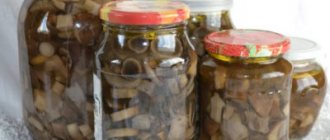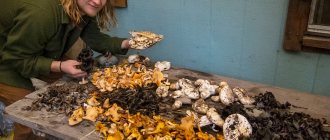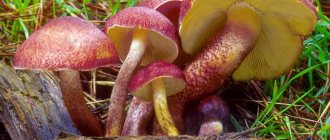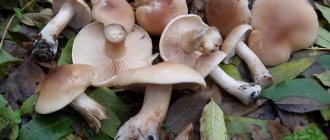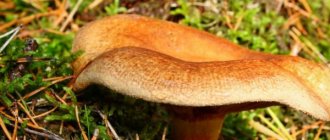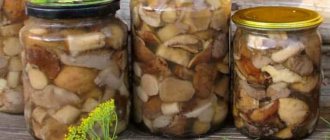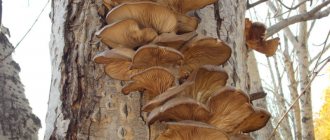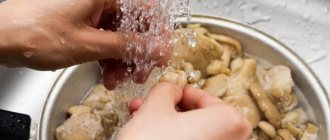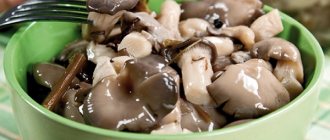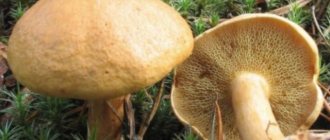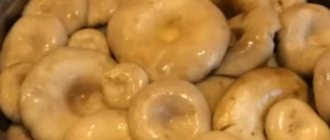What can be prepared from rows?
The most common varieties of sandpipers found in central Russia are the green sandpiper (greenfinch), the gray sandpiper and the red sandpiper. They have dense fleshy flesh, slightly darkening at the break. Sandpipers usually grow in large groups.
They are good fried, especially if fried with onions and potato slices. They can be marinated by adding to the marinade, in addition to vinegar and black peppercorns, 2-3 clove buds and 1-2 bay leaves. Then the taste and aroma of spices will overwhelm the characteristic sweetish taste of sandpiper, which not some people like.
Since the rows are edible mushrooms, they do not require pre-boiling or soaking. But they must be thoroughly washed before cooking to remove sand and small debris.
Sandpipers are also good in salted form. Usually they are salted in a “cold” way, placing thoroughly washed mushrooms in a plate-like layer on top in sterilized glass jars or ceramic dishes, and sprinkling each layer with salt. When all the mushrooms have been laid, you should salt the top layer, put a clean cotton rag scalded with boiling water on top, put a wooden circle on it (made of deciduous wood, also scalded with boiling water), and press down with pressure. The container with mushrooms should be stored in the refrigerator or cold cellar. In a few days they will release juice and become very heavy. You will be able to eat such salted sandpipers in about a month and a half. Sandpiper soups are usually not cooked, as they turn out much worse than soups from many other types of mushrooms.
How to pickle mushrooms for the winter
The technology for preserving pickled poplars is conventionally divided into two main methods: cold and hot. The first one requires a lot of time (more than 1.5 months), but the preparation has better taste, and the fruit body retains dense pulp. In this case, the poplar should be blanched to get rid of bitterness.
The hot preparation method is more popular, since you can get the finished dish in just a few days. Mushrooms have delicate flesh and are absolutely safe. Marinating floodplains does not require expensive components or special equipment, as confirmed by the following video:
The conservation process for sandpipers varies. In some recipes, mushrooms are boiled in salted water and then left to pour. Others involve cooking in a ready-made marinade, which allows you to preserve a more intense mushroom aroma.
The floodplains should be placed tightly in the jar, being careful not to damage the caps. Remaining air cushions between pieces of pulp can cause fermentation. Fill the jar with pickled sandpipers to the very neck, as indicated in the photo.
Taste qualities of the row
In general, it should be said that in terms of taste, row mushrooms are, of course, inferior to many mushrooms, primarily porcini, aspen, boletus, saffron milk caps, boletus, champignons, and chanterelles. Therefore, often even experienced mushroom pickers, who know well that these are edible mushrooms, do not collect sandpipers on principle. However, there are also mushroom pickers who like both the original “floury” aroma of such mushrooms and their sweetish taste.
- Number of servings: 2
- Preparation time: 20 minutes
- Cooking time: 20 minutes
How to cook sandbox mushrooms in a frying pan
The only drawback of these mushrooms is that they grow on sandy soils, so careful preliminary preparation is indispensable. The collected sandboxes need to be rinsed well and soaked in salted cold water for at least 3-4 hours, and preferably overnight. But the water needs to be changed periodically so that the sandpipers do not become sour. During this time, the plates and pores will open and the grains of sand will sink to the bottom. The easiest way is to simply fry the prepared mushrooms in a frying pan.
- Cook for 20 minutes from the moment of boiling, removing the foam.
- Rinse and leave to remove excess liquid.
- Place the mushrooms in a heated frying pan with oil. Fry.
- At the end of cooking, add salt, spices, pepper to taste. Cook for another 2 minutes.
Serve with potatoes or other side dish.
What kind of mushrooms are these underwater mushrooms?
Podtopolniki most often grow under poplars, so another name for these mushrooms is poplar row (poplar) or gray row. You can most often find row mushrooms in a poplar forest belt that separates collective farm fields or an aspen grove. I would say that these same mushrooms have character, despite the fact that having discovered a ridge, you can immediately cut a bucket, you have to bow to these mushrooms, no worse than the famous noble truffles. In appearance, the ground is covered with leaves and grass, and you might not even notice the friendly family at all. And if you poke the mound with a boot or stick, you can find a mature mushroom that has opened. But beautiful and tight young mushrooms need to be dug up on all fours. So you crawl behind them for several meters until the ridge ends.
Podtopolniks love sandy soil, so another name for these mushrooms is sandpipers. In some areas this mushroom is called frost. The smell of these mushrooms cannot be confused with anything else; it seems to me that they smell of freshness, frosty forest air. To some, this smell resembles the smell of flour.
The pulp of the tortoiseshell is white, dense and crispy. But these mushrooms need to be cooked correctly. Sometimes they are bitter, so they require additional soaking for several days in cold water.
We present to your attention a recipe for pickled podtopolniks. If you know how to salt ryadovki, podtopolniki (frosts or sandpipers, whatever you want to call them), please share the recipe in the comments! I remember once we were at a friend’s wedding in the village, and they treated us to salted floodplains, what a taste! I kept asking the groom's mother for the recipe, but we had such a good time that when we got ready to leave, we forgot about the recipe. I probably praised them so much that they gave me three three-liter jars! It’s delicious beyond words! We seasoned them with butter and sprinkled them with onions, mmmm! In the jar, the mushrooms were arranged with currant leaves and garlic slices, but how they were prepared remained a mystery to me!
In the main photo are our mother’s pickled podtopolniks, we call them frosts, they are also incredibly tasty. But Galina Kolokolnikova shared a step-by-step photo recipe with our notebook. The recipe is identical, only we add dried dill seeds to the mushrooms in addition to peppercorns and spices. You can use the spices that are more familiar to you to pickle and marinate mushrooms. Some may miss cloves, others garlic. Here, as they say, it comes down to taste and color...
Recipe for pickled sandpiper mushrooms
- sandpipers;
- water – 1000 ml;
- sugar – 1 tbsp. l.;
- salt – 2 tbsp. l.;
- vinegar – 50 ml;
- bay leaf – 1-2 pcs.;
- allspice – 5 pcs.
- Cover the mushrooms with water. Cook after boiling for 20 minutes, removing foam from time to time.
- Rinse. Pour water, add spices and cook for 30 minutes. At the very end, pour off the vinegar and stir. The mushrooms should settle to the bottom.
- Place the mushrooms in pre-sterilized jars and pour over the marinade.
Roll up, wrap and leave until cool. Place in a dark and cool place. The first sample can be taken after 2 weeks.
Pickled podtopolniks
The harvested crop should be immediately poured into a large container (basin, pan) and filled with cold water. Especially when the mushrooms are very dirty (as in our case). Soaking the mushrooms is necessary not only so that the sand, soil and foliage that stick to the mushroom caps come away, but more so that the bitterness goes away from them.
After cooking, an 8-liter bucket of raw mushrooms yields 2.5 liters of boiled mushrooms. For this amount of mushrooms you will need 1.5 liters of brine.
Sandpiper mushrooms with potatoes
- mushrooms – 400 g;
- potatoes – 4 pcs.;
- butter – 50 g;
- onion – 1 pc.;
- salt and spices;
- dill - a bunch.
Instead of butter, you can use vegetable oil, but then the taste of the dish will be slightly different.
- Boil the mushrooms. Large specimens should be cut into several pieces.
- Cut the potatoes into cubes and boil until half cooked.
- Combine ingredients, add salt and pepper.
- Fry mushrooms and potatoes in butter.
- Separately, fry the onion and add to the mushrooms.
Description and characteristics of edible species
The fungus sandpiper (podtopolnik) is one of the representatives of eukaryotes growing on loose soil. Some other species also love this soil: greenfinch (green grass), common oiler, fiddlehead (felt mushroom), pepper mushroom (pepper mushroom), chanterelle, saffron milk cap. Champignons can also settle on sand in the forest.
There are about 40 species of sandpipers in total. They also have a second name - rows. The most popular edible varieties of them, in addition to the topiary, include three: gray sandpiper, greenfinch, and red sandpiper.
- Gray sandpiper (gray row) is a conditionally edible mushroom. A characteristic feature is the mouse color of the cap. Suitable for eating only after soaking and boiling.
- Greenfinch - it cannot be confused with anything else because of the color of the cap and stem, which does not change even after prolonged heat treatment. Before use, the mushroom must also be soaked and boiled.
- The sandpiper is red - it has a cap of the corresponding color, and its distinctive feature is the yellow flesh, which emits a sour smell. Before cooking, soak in salted water for at least a day. It is boiled, fried, and salted.
The sandpiper mushroom (poplar row) belongs to the Ryadovkov family, or Trikholomov, the genus Ryadovok. Scientific name: Tricholoma populinum. Other names: sandstone, sandstone, poplar, podtopolnik, podtopolevik. Popular nicknames: bastards, frosts.
The sandpiper mushroom looks like this:
The cap has a diameter of 6 to 12 cm. At first it is slightly convex, hemispherical, with thin edges turned inward, then it straightens out and becomes fleshy. In wet weather it is slightly slippery, pinkish-brown in color, beige with brown splashes.
The hymenophore (back side of the cap) is lamellar. The membranes are thin and frequent. At a young age they are creamy or milky; over time they turn brown in sync with the cap.
The pulp when cut is elastic, white, soft, fleshy. Under the skin it is slightly reddish or brownish, and has a bitter floury taste. The mushroom is also easy to distinguish from other species by its characteristic aroma - a mixture of flour and fresh cucumber smells.
The leg is of medium length - up to 7 cm, thin, solid. Its thickness is 1.5–4 cm. The color can vary from milky to white. It has a scaly coating on it. When pressed, purple spots form.
A little history
This species was first described by the Danish botanist and mycologist Jacob Emmanuel Lange in 1933.
Video
Description
The sandpiper mushroom is not found often and is a real find for mushroom pickers. The unusual name appeared due to the fact that it grows on sandy soil, under poplars, lining up in whole rows of families.
The sandbox boasts a large list of titles:
- row;
- floodplain;
- poplar;
- sandstone.
In different areas, sandpiper mushrooms are given their own definitions:
- poplars;
- spoilers;
- frosties.
The plant is plastic, soft, and reproduces by spores. The poplar's cap is fleshy, light brown in color, with a diameter of 6 to 12 cm. The inside is reddish in color. First convex in the middle, at the edges it is turned inward. Over time, the cap straightens and bends down.
The plates at the bottom of the cap are thin and frequent. In young poplars they are light cream in color. And a more mature plant has brown plates.
The stem of poplars is not very high (5-7 cm), thick, almost smooth with a slight thickening towards the bottom. The inside is fleshy and solid. The color is light milky or white.
Frosts are common in coniferous, deciduous and mixed forests. These late representatives of the mushroom kingdom grow and bear fruit from the end of August, throughout the deciduous period, until the first snow falls.
Is it possible to grow floodplain yourself?
It is suitable for cultivation and breeding in artificial conditions - both indoors and outdoors. The technique is simple, you just need to follow a few technological rules. On a farm scale, almost no one does this, since the mushroom is not in great demand. However, amateurs can grow this variety for themselves if they wish.
The most important conditions are the required temperature and sufficient humidity. Poplar row fruits set at a temperature of no more than 15 °C. Such an environment can be created in a basement or cellar. However, it is better to breed sandpipers outdoors.
The process must contain the following phases:
- First you need to make a substrate. To do this, combine 50 g of mycelium, a liter of water, 100 g of chalk and 5 kg of soil (preferably a turf layer of soil with rotted twigs, taken under a poplar).
- Pour the mixture into boxes or boxes, add 5 cm of wet soil on top.
- The soil with mycelium is laid out on the beds, and everything is covered with film to maintain high humidity.
- The best temperature for mycelium germination is 20 °C.
- When the soil is overgrown with it, the film is removed and the substrate is transferred to the shade. The first mushrooms will appear in a month and a half.
- After harvesting, the soil is moistened, then soil is added.
- Before winter frosts, the area with mycelium is covered with leaves or grass.
- In the spring, when the air temperature reaches 10 °C, the beds are opened.
False inedible mushrooms look-alikes
These include several types of rows: leopard print, mouse pointed, soap, brown, white.
Comparative table of look-alikes that are not suitable for consumption.
| Name | How to differentiate |
| Sandpiper (poplar row) | The cap is brownish-pinkish in color, the flesh is reddish, soft, with a taste of flour. The leg is medium, fleshy, pinkish or white-brown, with a scaly-flaky coating. When pressed, brown spots form. |
| Leopard line (tiger) | Characteristic scaly silver-gray spots on the cap. There is no floury smell and taste, like that of the floodflower. Very toxic. |
| Mouse pointed row | There is a dark protruding mound in the middle of the cap. There is no smell. Old specimens are covered with yellow spots. Slightly toxic. |
| Soap row | Reddened flesh on the cut. The smell is soapy-fruity, unpleasant. She looks more like a sandpiper than others. |
| Brown row | Painted dark brown. When cut, the flesh turns red and emits an unpleasant odor. |
| White row | The hat is spread out, flat, with thick wavy edges. When broken, the flesh turns pink and has a pungent odor of radish. |
The difference between poplar, its twins and false twins can be seen in the photo picture.
Characteristics of sandpipers
This genus of mushrooms has up to fifty species, each of which has its own characteristics, but a generalized description of sandstone can be given.
Appearance and photo
Sandstone can be recognized by certain characteristics. Among them are:
- Spread in large groups.
- Growing in rows.
- The presence of a tubercle on the caps of old mushrooms.
- The habit of hiding in the sand or under leaves.
The most striking feature of the edible row is the flour aroma. You can see what sandstone looks like in the photo.
You may be interested in:
How to distinguish volushki from saffron milk caps and how are they similar (20 photos)? Some of the most popular mushrooms in our country are considered to be mushrooms and saffron milk caps. These species are very similar to an inexperienced...Read more...
Morphology
The sandpiper's cap is convex, fleshy, and has the shape of a hemisphere. As it grows, it straightens and bends, acquiring an irregular shape. The edges of the cap are thin, curled, and cracked. In young individuals, the surface is slightly wet and slippery. The diameter of the cap is from 6 to 12 cm.
Depending on the species, it can have the following colors:
- green;
- grey;
- brown;
- red;
- shades of brown.
The leg is fleshy. In cross section it ranges from 1.5 to 4 cm, in length - from 3 to 8 cm. The color of the leg changes with age from shades of white to red-brown. When pressed, the surface of the leg darkens.
The plates of young mushrooms are white. With age they acquire a reddish-brown tint. The pulp of the row is thick, fleshy, white. Under the skin of the cap it is a little reddish, and under the skin of the stem it is grayish. Almost all types are characterized by a certain aroma, reminiscent of the smell of freshly ground flour.
Place of distribution
Sandstones grow in large families. Their rows can be found in the following places:
- coniferous forests;
- deciduous forests;
- parks;
- planting;
- roadsides.
Good to know!
Most often they are found under poplars and pine trees, securely hidden under layers of sand or fallen leaves. Mushrooms prefer sandy soil.
Rows are most popular in the Omsk, Volgograd, and Saratov regions of Russia, Kazakhstan, and the Altai Territory. These areas are considered poor in mushrooms, so sandpipers are actively eaten here.
You may be interested in:
Description and photos of edible mushrooms Mushroom pickers are not born, but become. You can master the complex science of edible and poisonous mushrooms at any age,...Read more...
Edible or inedible
Rowers can be either edible or toxic. The following mushrooms are edible:
- black scaly;
- giant;
- dove;
- yellow-brown;
- massive;
- matsutake;
- Mongolian;
- red;
- poplar;
- grey;
- carved;
- earthy.
Commonly edible species include the silver, golden, booted, yellow-red, bearded sandpiper and greenfinch. All other representatives of the rows are inedible or toxic.
Difference from false mushrooms
Edible species are often confused with inedible or poisonous rowers. Below is a list of the most common false mushrooms with a description of the main differences.
| Species name | Features |
| Leopard |
|
| Mouse pointed |
|
| Soapy |
|
| Brown |
|
| White |
|
The main sign that sandstone is edible is its floury smell.
Collection rules and conditions
Sandstone begins to bear fruit in August. The last mushrooms are harvested in October, and some species survive until the first frost.
Attention!
In order not to damage the mycelium, the rows are cut with a knife. Breaking off can lead to the death of the entire family.
You can collect rows only in relatively environmentally friendly places. The fruiting bodies of mushrooms tend to absorb toxins from the external environment, as a result of which even edible species become poisonous. You can check mushrooms for toxicity in a fairly simple way: if the flesh of the sandpiper is white, it is suitable for consumption, yellow flesh indicates unsuitability.
There are more than 40 types of sandstones in nature. But the following types are considered the most common:
- Greenfinch is a sandpiper with an unusual green color.
Even after heat treatment, the color does not change. Sometimes there are specimens with a yellowish tint. This species belongs to the conditionally edible category. It is eaten only if complex preparation technology is followed and in very limited quantities. The cap is convex and has a small tubercle in the middle. As they grow older, scales appear on the surface. The leg of the greenfinch is short but wide. It has a dense elastic texture. The color of the legs is also green. The lemon-colored plates have the characteristic smell of flour in the rows. The pulp is white. In overripe or spoiled specimens, it acquires a yellow tint. - Gray sandstone – poses a threat to human health if eaten raw. Despite belonging to the category of edible, it becomes so only after heat treatment. The cap is fleshy and round. Over time, it acquires a flat shape and uneven edges. The cap is slightly flattened and has a tubercle in the middle.
Gray row
The surface is painted with an ashen shade of gray. The leg is whitish, sometimes with a gray-yellow tint. Initially white plates become yellow or gray over time. The pulp is white. When broken, it turns yellow, emitting a powdery odor. - Red Sandstone – different sources are classified into different categories. Some describe this species as edible, others classify them as conditionally edible. One way or another, but, by analogy with gray sandstones, red ones can be eaten only after processing. The cap is convex, and as it matures it takes on a flat shape. There is a small bump in the middle.
Red sandstone
The surface is sticky. In older individuals, scales form on it. The surface color varies from red to brown. The leg is straight, slightly thickened below. The surface is white, the bottom is painted yellow-red. Brown spots appear on old rows. Young mushrooms have white plates. With age, they turn yellow and become covered with red spots. The pulp is white, with a yellowish tint. When cut, it smells like flour.
You may be interested in:
Appearance and description of saffron mushrooms and where do they grow (23 photos)? Saffron milk caps are one of the most common mushrooms in our country. They are popular not only due to their exquisite taste,...Read more...
Benefits and medicinal properties
Zabaluiki contain useful macro- and microelements, vitamins:
- acids – citric, tartaric, oxalic;
- minerals – calcium, selenium, phosphorus, chlorine, sodium, magnesium, potassium;
- enzymes that break down glycogen and fats, preventing their accumulation;
- vitamins A, C, PP, group B.
These substances have a positive effect on the body, accelerate metabolic processes, help lower blood pressure, normalize glucose and cholesterol levels in the blood, improve gastrointestinal function, and increase appetite.
Help! Sandstone is an edible mushroom of the third category. Since its energy value is low (24 kcal per 100 g), it is well suited for dietary nutrition.
Cooking recipes
Before cooking, the subflorid grass must be cleaned, washed, soaked and boiled, as it tends to taste bitter. The fruits can be boiled, fried, pickled, pickled, frozen for storage, made into caviar, canned, etc.
Cleaning and pre-treatment
The main difficulty of processing lies in preliminary cleaning. The specificity of these mushrooms is such that when they emerge from the soil, they become dirty - both the cap on top and the gynophore plates. If they are not processed well enough, if they are poorly cleaned, washed and not soaked, then the blanks may deteriorate and the jars may burst.
- Each specimen must be thoroughly cleaned of dirt and debris and rinsed in cold water.
- Place the product in a deep saucepan, add salted water, and leave overnight.
- In the morning, mix everything. The pores of the floodplain will open and sand will pour out.
- Carefully remove the fruits so as not to catch any debris from the bottom, rinse again in running water to remove the bitterness. If necessary, clean dirty areas with a brush.
The row is ready for cooking and creating various dishes.
Reference! Some people prefer to soak the fruits for 2-3 days to get rid of bitterness as much as possible. But then the vessel should be placed in a cold place and the water should be changed several times a day so that the mushrooms do not ferment.
Cooking
Since the rows are a conditionally edible species, this procedure is necessary in order to eliminate unpleasant moments when consuming them - poisoning of varying degrees. For cooking take:
- water – 1 l;
- subtopoleviki – 1 kg;
- citric acid - on the tip of a knife;
- cloves - 2 pieces;
- salt – 1 tsp.
- Pour water into a saucepan, add citric acid, salt, and bring to a boil.
- Place the washed and soaked zabaluyki into a container.
- Cook for 20 minutes covered. At the same time, periodically remove the foam from the surface.
- Add spices and keep on fire for another 20 minutes. There is a reliable way to determine the readiness of the fruits: they will sink to the bottom of the pan.
Pickling
Mushrooms prepared in this way are the best appetizer for porridge and potatoes, an original filling for baked goods, and a wonderful ingredient for salad.
Ingredients for marinating:
- water – 1 l;
- undertopolniks – 3 kg;
- vinegar - 1.5 tbsp. l.;
- salt – 70 g;
- dill - 2-3 umbrellas;
- laurel – 2-3 leaves.
You need to marinate sandpipers for the winter like this:
- Pour water over the already boiled fruits, place on the stove, and turn on high heat. They should boil for 10 minutes.
- Then reduce the flame and wait the same amount of time.
- Wash the cottonwoods.
- Place in a container, fill with water, add vinegar, bay leaf, dill, salt.
- Turn the heat to maximum, when everything boils, turn it down. The fruiting bodies should cook for 3–5 minutes.
- Drain the mushrooms in a colander and let cool.
- Transfer to pasteurized jars, quickly fill with marinade, and seal with lids.
Canned food should be stored in a cool place.
Freezing
This option for preparing rows for the winter is the simplest. For it, it is advisable to use dense, clean, fresh specimens. This requirement is best met by young and whole fruiting bodies.
Sequencing:
- Cut off the legs of cleaned, soaked and washed floodplains.
- Place them in boiling salted water. Cook for half an hour.
- Let drain in a colander and place on a dry towel.
- Once dry, place on a tray and place in the freezer.
- You can use food containers or plastic bags for layout.
Preparing for pickling poplar rows
Podtopolniki are not very popular among mushroom pickers. However, those who are familiar with the taste of pickled sandpipers annually prepare the treat for future use. Harvest time is August-October. Spring varieties are harvested in May.
The taste and safety of winter harvesting depend on the primary processing of freshly picked mushrooms. The main manipulations are carried out immediately after harvesting, since the row quickly becomes unusable.
Attention! Podtopolnik, which emits an unpleasant odor (similar to dust, rot), is a poisonous species. Such mushrooms should not be eaten.
Step-by-step instructions for preparing floodplains will help you avoid mistakes during the marinating process:
- It is necessary to sort through the mushrooms, remove damaged or spoiled specimens;
- for harvesting, select strong, fleshy fruiting bodies;
- sort the crop by size. Cut large caps into pieces;
- rinse with cold water;
- place the floodplains in a deep basin, fill with cold salted water. As a result, the bitterness will leave the mushroom body, the pulp will retain its color;
- leave the container in a cool, dark room to avoid fermentation;
- soak the collection for 1-1.5 days, regularly changing the water (every 4 hours);
- rinse everything again to get rid of sand and debris;
- clean the crop and cook for half an hour. Water should be salted at the rate of 10 g per liter of liquid;
- skim off foam during cooking;
- strain the floodwaters when they completely settle to the bottom of the pan;
- Rinse again under running water and dry.
Pickled poplar row
At the end of all procedures, the poplar rows are completely ready for further pickling. The next step is to sterilize the containers and lids. These actions are mandatory, as they guarantee the safety of the quality of the workpiece.
Interesting Facts
The main benefit of edible rows is the B vitamins they contain. An antibiotic that fights tubercle bacilli is also obtained from mushrooms.
In a number of countries, ryadovki are considered an inedible and even poisonous forest fruit, and in some – a delicacy. They are cultivated artificially and exported.
From the powder of dried rows of some varieties, facial lotions are made that reduce skin oiliness and eliminate acne.
It is quite easy to grow these mushrooms at home. They are bred in the same way as champignons.
Sandpiper is an edible mushroom. With the right processing method, it becomes an excellent, tasty snack. When collecting it, you need to be careful and careful not to confuse it with unedible and toxic species. You should focus not only on the appearance of the mushroom, but also on the smell - it should be mealy.
